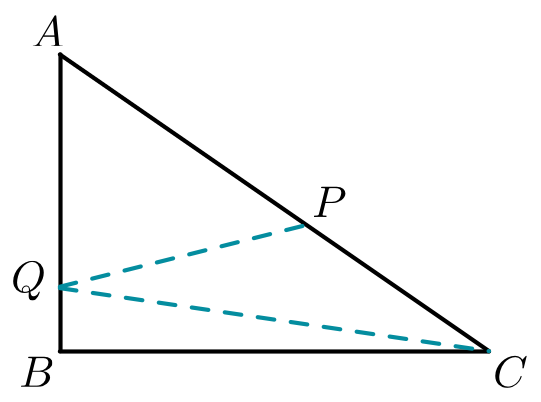Line from nowhere
 Let
A
B
C
be a right triangle with
∠
A
B
C
=
9
0
∘
. Let
P
be a point on segment
A
C
such that
P
C
A
P
=
2
3
and let
Q
be a point on segment
A
B
such that
A
Q
=
3
⋅
Q
B
. If
∠
A
Q
P
=
2
∠
P
Q
C
, what is the measure (in degrees) of
∠
P
Q
C
?
Let
A
B
C
be a right triangle with
∠
A
B
C
=
9
0
∘
. Let
P
be a point on segment
A
C
such that
P
C
A
P
=
2
3
and let
Q
be a point on segment
A
B
such that
A
Q
=
3
⋅
Q
B
. If
∠
A
Q
P
=
2
∠
P
Q
C
, what is the measure (in degrees) of
∠
P
Q
C
?
The answer is 36.
This section requires Javascript.
You are seeing this because something didn't load right. We suggest you, (a) try
refreshing the page, (b) enabling javascript if it is disabled on your browser and,
finally, (c)
loading the
non-javascript version of this page
. We're sorry about the hassle.
5 solutions
Let θ = ∠ P Q C . Then ∠ A Q P = 2 θ and ∠ B Q C = 1 8 0 ∘ − 3 θ .
 "Line from nowhere"
"Line from nowhere"
Now let a = B C and let c = A B . Draw a perpendicular from P to A B so that it meets A B at D . Then P D ⊥ A B and P D ∥ B C . Therefore △ A P D is similar to △ A C B by a factor of 5 3 (because A C A P = 5 3 ). Thus D P = 5 3 a and A D = 5 3 c . Thus D B = 5 2 c . Furthermore, since A Q = 3 Q B , then Q B = 4 c and A Q = 4 3 c . Hence, D Q = D B − Q B = 5 2 c − 4 c = 2 0 3 c Therefore,, in △ D Q P we have: t a n ( 2 θ ) = D Q P D = 3 c / 2 0 3 a / 5 = c 4 a Similarly, in △ B Q C , we hve: t a n ( ∠ B Q C ) = t a n ( 1 8 0 ∘ − 3 θ ) = Q B B C = c / 4 a = c 4 a
Hence, t a n ( 2 θ ) = t a n ( 1 8 0 ∘ − 3 θ ) . Since both of these angles are strictly between 0 and 1 8 0 ∘ , then they must be equal. Hence, 2 θ = 1 8 0 ∘ − 3 θ 5 θ = 1 8 0 ∘ θ = 3 6 ∘
choose M is midpoint of PC, => PQ // BM => PQA angle = QBM angle BM intersects QC at K => K is midpoint of QC Because BQC is a right triangle => QBM angle = BQC angle => 5 PQC angle = 180 degree => PQC angle = 36 degree
How do you know that PQ is parallel to BM?
[AQP] means angle AQP. On ray AB, denote K such that:BQ=BK. Hence: AQ/QK=3/2 => AQ/QK=AP/PC => QP is parallel to KC. Thus, [AQP]=[BKC]. On the other hand: [BKC]= BQC . So, [AQP]=[BQC]=2[PQC]. We have: [AQP]+[PQC]+[BQC]=180 => 2[PQC]+[PQC]+2[PQC]=180 => [PQC]=36. 36 is the correct answer.
K is PQ x CD, call H in the line CD that is orthogonal with line BC and satisfies: Q H ⊥ C D , C D ⊥ B C ⇒ Q A K C = P A C P = 3 2 ABCD is a rectangular, because: A B Q A = 4 3 ⇒ K C = 4 3 × 3 2 × A B = 2 A B Q B = 4 A B ⇒ H C = Q B = 2 K C ⇒ K Q = Q C , ∠ K Q H = ∠ H Q C = 2 ∠ P Q C ⇒ ∠ H Q C = 5 H Q A = 1 8 o ⇒ ∠ P Q C = 3 6 o
Q splits AB in ratio 3:1. So lets be QB=y then AQ=3y. Let T be a point on AB such that BT=y, T on opposite direction to Q. Because CB is perpendicular on AB then CB is bisecting angle TCQ. Let be angle PQC=a. Q spits AT in ratio 3:2 because AQ=3y and QT=2y. Because P splits AC also in rratio 3:2 then QP is parallel with TC. Angles PQC=QCT=2*QCB and so QCB=a/2 In triangle CBQ we have BQC=180-3a and BCQ=a/2. Then 180+3a+a/2=90 which give the solution a=36. If you draw the points, the solution will be much clear than the writings above.
Log in to reply
how do you know that BQC = 180 - 3a?
Log in to reply
Because PQC=a and AQP=2PQC=2a an so AQC =3a and then CQB=180-3a
Log in to reply
@Marius Munteanu – How do you get AQP = 2PQC?
Log in to reply
@Shiv Gaur – Read the problem please. It says if AQP=2PQC then find PQC.
It's obvious sum of two angles is 3a third angle will be 180-3a
Extend PQ and BC such that they intersect at E .
Apply Menelaus Theorem .
Result => CE = 2BE or
B is midpoint of CE .
By congruency , angle BQC = angle BQE = angle AQP
You will get Theta = 36